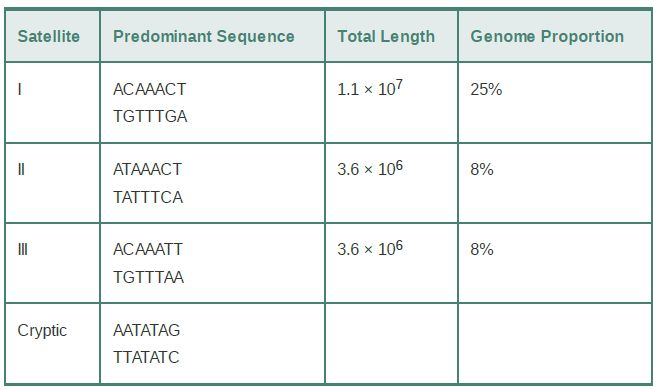
Arthropod Satellites Have VeryShort Identical Repeats
 المؤلف:
JOCELYN E. KREBS, ELLIOTT S. GOLDSTEIN and STEPHEN T. KILPATRICK
المؤلف:
JOCELYN E. KREBS, ELLIOTT S. GOLDSTEIN and STEPHEN T. KILPATRICK
 المصدر:
LEWIN’S GENES XII
المصدر:
LEWIN’S GENES XII
 الجزء والصفحة:
الجزء والصفحة:
 18-3-2021
18-3-2021
 2039
2039
Arthropod Satellites Have VeryShort Identical Repeats
KEY CONCEPT
- The repeating units of arthropod satellite DNAs are only a few nucleotides long. Most of the copies of the sequence are identical.
In arthropods, as typified by insects and crustaceans, each satellite DNA appears to be rather homogeneous. Usually, a single, very short repeating unit accounts for more than 90% of the satellite.
This makes it relatively straightforward to determine the sequence. The fly D. virilis has three major satellites and a cryptic satellite; together they represent more than 40% of the genome. TABLE1 summarizes the sequences of the satellites. The three major satellites have closely related sequences. A single base substitution is sufficient to generate either satellite II or III from the sequence of satellite I.
TABLE .1 Satellite DNAs of D. virilis are related. More than 95% of each satellite consists of a tandem repetition of the predominant sequence.

The satellite I sequence is present in other species of Drosophila related to D. virilis and so might have preceded speciation. The sequences of satellites II and III seem to be specific to D. virilis and so might have evolved from satellite I following speciation.
The main feature of these satellites is their very short repeating unit of only 7 bp. Similar satellites are found in other species. D. melanogaster has a variety of satellites, several of which have very short repeating units (5, 7, 10, or 12 bp). We can find comparable satellites in crustaceans.
The close sequence relationship found among the D. virilis satellites is not necessarily a feature of other genomes, for which the satellites might have unrelated sequences. Each satellite has arisen by a lateral amplification of a very short sequence. This sequence can represent a variant of a previously existing satellite (as in D. virilis), or it could have some other origin.
Satellites are continually generated and lost from genomes. This makes it difficult to ascertain evolutionary relationships, because a current satellite could have evolved from some previous satellite that has since been lost. The important feature of these satellites is that they represent very long stretches of DNA of very low sequence complexity, within which constancy of sequence can be maintained.
One feature of many of these satellites is a pronounced asymmetry in the orientation of base pairs on the two strands. In the example of the major D. virilis satellites , one of the strands is much richer in T and G bases. This increases its buoyant density so that upon denaturation this heavy strand (H) can be separated from the complementary light strand (L). This can be useful in sequencing the satellite.
 الاكثر قراءة في مواضيع عامة في الاحياء الجزيئي
الاكثر قراءة في مواضيع عامة في الاحياء الجزيئي
 اخر الاخبار
اخر الاخبار
اخبار العتبة العباسية المقدسة


